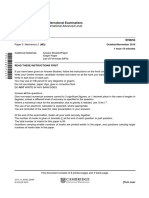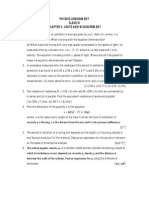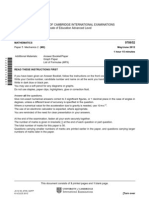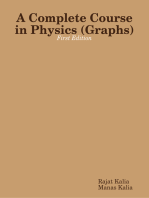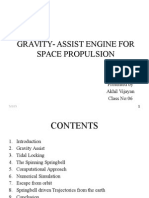9709 s11 QP 42
9709 s11 QP 42
Uploaded by
sohailbabarCopyright:
Available Formats
9709 s11 QP 42
9709 s11 QP 42
Uploaded by
sohailbabarOriginal Title
Copyright
Available Formats
Share this document
Did you find this document useful?
Is this content inappropriate?
Copyright:
Available Formats
9709 s11 QP 42
9709 s11 QP 42
Uploaded by
sohailbabarCopyright:
Available Formats
w w w e tr .
X m ap eP
UNIVERSITY OF CAMBRIDGE INTERNATIONAL EXAMINATIONS General Certicate of Education Advanced Subsidiary Level and Advanced Level 9709/42
May/June 2011 1 hour 15 minutes Additional Materials: Answer Booklet/Paper Graph Paper List of Formulae (MF9)
s er om .c
MATHEMATICS Paper 4 Mechanics 1 (M1)
*2579131893*
READ THESE INSTRUCTIONS FIRST If you have been given an Answer Booklet, follow the instructions on the front cover of the Booklet. Write your Centre number, candidate number and name on all the work you hand in. Write in dark blue or black pen. You may use a soft pencil for any diagrams or graphs. Do not use staples, paper clips, highlighters, glue or correction uid. Answer all the questions. Give non-exact numerical answers correct to 3 signicant gures, or 1 decimal place in the case of angles in degrees, unless a different level of accuracy is specied in the question. Where a numerical value for the acceleration due to gravity is needed, use 10 m s2. The use of an electronic calculator is expected, where appropriate. You are reminded of the need for clear presentation in your answers. At the end of the examination, fasten all your work securely together. The number of marks is given in brackets [ ] at the end of each question or part question. The total number of marks for this paper is 50. Questions carrying smaller numbers of marks are printed earlier in the paper, and questions carrying larger numbers of marks later in the paper.
This document consists of 4 printed pages.
JC11 06_9709_42/2R UCLES 2011
[Turn over
2 1
A load is pulled along horizontal ground for a distance of 76 m, using a rope. The rope is inclined at 5 above the horizontal and the tension in the rope is 65 N.
(i) Find the work done by the tension.
[2]
At an instant during the motion the velocity of the load is 1.5 m s1 .
(ii) Find the rate of working of the tension at this instant.
[2]
An object of mass 8 kg slides down a line of greatest slope of an inclined plane. Its initial speed at the top of the plane is 3 m s1 and its speed at the bottom of the plane is 8 m s1 . The work done against the resistance to motion of the object is 120 J. Find the height of the top of the plane above the level of the bottom. [4]
v (m s1)
50
8 0 0 5 12 102
t (s)
The velocity-time graph shown models the motion of a parachutist falling vertically. There are four stages in the motion: falling freely with the parachute closed, decelerating at a constant rate with the parachute open, falling with constant speed with the parachute open, coming to rest instantaneously on hitting the ground. [2]
(i) Show that the total distance fallen is 1048 m.
The weight of the parachutist is 850 N.
(ii) Find the upward force on the parachutist due to the parachute, during the second stage.
[5]
UCLES 2011
9709/42/M/J/11
3 4
12 N FN
30
10 N
The three coplanar forces shown in the diagram act at a point P and are in equilibrium.
(i) Find the values of F and .
[6]
(ii) State the magnitude and direction of the resultant force at P when the force of magnitude 12 N is removed. [2]
Two particles P and Q are projected vertically upwards from horizontal ground at the same instant. The speeds of projection of P and Q are 12 m s1 and 7 m s1 respectively and the heights of P and Q above the ground, t seconds after projection, are hP m and hQ m respectively. Each particle comes to rest on returning to the ground.
(i) Find the set of values of t for which the particles are travelling in opposite directions.
[3]
(ii) At a certain instant, P and Q are above the ground and 3hP = 8hQ . Find the velocities of P and Q at this instant. [5]
80 cm
50 cm
50 cm
R
A small smooth ring R, of mass 0.6 kg, is threaded on a light inextensible string of length 100 cm. One end of the string is attached to a xed point A. A small bead B of mass 0.4 kg is attached to the other end of the string, and is threaded on a xed rough horizontal rod which passes through A. The system is in equilibrium with B at a distance of 80 cm from A (see diagram).
(i) Find the tension in the string. (ii) Find the frictional and normal components of the contact force acting on B.
[3] [4]
(iii) Given that the equilibrium is limiting, nd the coefcient of friction between the bead and the rod. [2]
UCLES 2011
9709/42/M/J/11
[Turn over
4 7
A walker travels along a straight road passing through the points A and B on the road with speeds 0.9 m s1 and 1.3 m s1 respectively. The walkers acceleration between A and B is constant and equal to 0.004 m s2 .
(i) Find the time taken by the walker to travel from A to B, and nd the distance AB.
[3]
A cyclist leaves A at the same instant as the walker. She starts from rest and travels along the straight road, passing through B at the same instant as the walker. At time t s after leaving A the cyclists speed is kt3 m s1 , where k is a constant.
(ii) Show that when t = 64.05 the speed of the walker and the speed of the cyclist are the same, correct to 3 signicant gures. [5] (ii) Find the cyclists acceleration at the instant she passes through B.
[2]
Permission to reproduce items where third-party owned material protected by copyright is included has been sought and cleared where possible. Every reasonable effort has been made by the publisher (UCLES) to trace copyright holders, but if any items requiring clearance have unwittingly been included, the publisher will be pleased to make amends at the earliest possible opportunity. University of Cambridge International Examinations is part of the Cambridge Assessment Group. Cambridge Assessment is the brand name of University of Cambridge Local Examinations Syndicate (UCLES), which is itself a department of the University of Cambridge. UCLES 2011 9709/42/M/J/11
You might also like
- RANGER 5 AXIS ROBOT OPERATIONS MANUAL AB VERSION REV 2.7 EuroDocument87 pagesRANGER 5 AXIS ROBOT OPERATIONS MANUAL AB VERSION REV 2.7 EuroErnie Sergejenko0% (1)
- Lab Report FormatDocument6 pagesLab Report FormatRhenz Bhovie ViloriaNo ratings yet
- A Level Math 41 Nov2013Document4 pagesA Level Math 41 Nov2013Ahmad HaikalNo ratings yet
- University of Cambridge International Examinations General Certificate of Education Advanced Subsidiary Level and Advanced LevelDocument4 pagesUniversity of Cambridge International Examinations General Certificate of Education Advanced Subsidiary Level and Advanced LevelHubbak KhanNo ratings yet
- 9709 s15 QP 43Document4 pages9709 s15 QP 43Syakir AkeNo ratings yet
- Past PapersDocument4 pagesPast PapersShayan MaqsoodNo ratings yet
- M1pp Jan13Document99 pagesM1pp Jan13JW1212No ratings yet
- M June 2014 Paper 4 Questions 41Document4 pagesM June 2014 Paper 4 Questions 41Wendell LuNo ratings yet
- University of Cambridge International Examinations General Certificate of Education Advanced Subsidiary Level and Advanced LevelDocument4 pagesUniversity of Cambridge International Examinations General Certificate of Education Advanced Subsidiary Level and Advanced Levelapurbodebnath5belyNo ratings yet
- 9709 s10 QP 42Document4 pages9709 s10 QP 42Abrar JahinNo ratings yet
- 9709 s03 QP 4Document4 pages9709 s03 QP 4linusshyNo ratings yet
- 9709 s04 QP 4Document4 pages9709 s04 QP 4tess_15No ratings yet
- Cambridge International Advanced Subsidiary and Advanced LevelDocument4 pagesCambridge International Advanced Subsidiary and Advanced LevelSabih AzharNo ratings yet
- MathematicsDocument4 pagesMathematicsdkorean493No ratings yet
- M1 2Document4 pagesM1 2Alex WangNo ratings yet
- University of Cambridge International Examinations General Certificate of Education Advanced Subsidiary Level and Advanced LevelDocument4 pagesUniversity of Cambridge International Examinations General Certificate of Education Advanced Subsidiary Level and Advanced LevelHubbak KhanNo ratings yet
- University of Cambridge International Examinations General Certificate of Education Advanced Subsidiary Level and Advanced LevelDocument4 pagesUniversity of Cambridge International Examinations General Certificate of Education Advanced Subsidiary Level and Advanced LevelHubbak KhanNo ratings yet
- University of Cambridge International Examinations General Certificate of Education Advanced Subsidiary Level and Advanced LevelDocument4 pagesUniversity of Cambridge International Examinations General Certificate of Education Advanced Subsidiary Level and Advanced LevelLalith77No ratings yet
- MathematicsDocument4 pagesMathematicsLalith77No ratings yet
- Cambridge International Advanced Subsidiary and Advanced LevelDocument4 pagesCambridge International Advanced Subsidiary and Advanced LevelKelvin SerimweNo ratings yet
- Cambridge International Advanced Subsidiary and Advanced LevelDocument4 pagesCambridge International Advanced Subsidiary and Advanced LevelJohn DoeNo ratings yet
- 9709 w10 QP 42Document4 pages9709 w10 QP 42Sherman TanNo ratings yet
- Mechanics MarchDocument73 pagesMechanics MarchMuhammad FayazNo ratings yet
- Compiled P4 (M1)Document116 pagesCompiled P4 (M1)Roshaan Ashraf0% (1)
- 9709 w05 QP 4Document4 pages9709 w05 QP 4Franklin RamballyNo ratings yet
- Cambridge International Advanced Subsidiary and Advanced LevelDocument4 pagesCambridge International Advanced Subsidiary and Advanced Levelzuh blackNo ratings yet
- November 2015 (v1) QP - M1 CIE Maths A-LevelDocument4 pagesNovember 2015 (v1) QP - M1 CIE Maths A-LevelAbraham MensahNo ratings yet
- 9709 s13 QP 41Document4 pages9709 s13 QP 41Abrar JahinNo ratings yet
- Math m1 Jan 2010Document4 pagesMath m1 Jan 2010Hoang Van NguyenNo ratings yet
- Cambridge International Advanced Subsidiary and Advanced LevelDocument4 pagesCambridge International Advanced Subsidiary and Advanced LevelBassem Khalid YasseenNo ratings yet
- Cambridge International Advanced Subsidiary and Advanced LevelDocument4 pagesCambridge International Advanced Subsidiary and Advanced LevelWarda Ul HasanNo ratings yet
- 9709 s13 QP 42Document4 pages9709 s13 QP 42Irtiza HussainNo ratings yet
- 9709 w06 QP 4Document4 pages9709 w06 QP 4michael hengNo ratings yet
- 9709 s10 QP 43Document4 pages9709 s10 QP 43sriniyfaNo ratings yet
- Cambridge International Advanced LevelDocument4 pagesCambridge International Advanced LevelBassem Khalid YasseenNo ratings yet
- University of Cambridge International Examinations General Certificate of Education Advanced Subsidiary Level and Advanced LevelDocument4 pagesUniversity of Cambridge International Examinations General Certificate of Education Advanced Subsidiary Level and Advanced Levelahnaf.sharar.rhineNo ratings yet
- 9709 w15 QP 43Document4 pages9709 w15 QP 43yuke kristinaNo ratings yet
- University of Cambridge International Examinations General Certificate of Education Advanced Subsidiary Level and Advanced LevelDocument4 pagesUniversity of Cambridge International Examinations General Certificate of Education Advanced Subsidiary Level and Advanced LevelPrivate of ScienceNo ratings yet
- Cambridge International Advanced Subsidiary and Advanced LevelDocument4 pagesCambridge International Advanced Subsidiary and Advanced LevelSabih AzharNo ratings yet
- 9709 w16 QP 42Document4 pages9709 w16 QP 42Yadvi ChoolunNo ratings yet
- Topic 6 ReviewDocument46 pagesTopic 6 ReviewBrady LiamNo ratings yet
- 2.2 ForceDocument16 pages2.2 ForcecetinNo ratings yet
- Miscellaneous Practice 4Document3 pagesMiscellaneous Practice 4Bryan Fury100% (2)
- 9709 w15 QP 53Document4 pages9709 w15 QP 53yuke kristinaNo ratings yet
- 1367332824home Assignment XiDocument13 pages1367332824home Assignment Ximahima2408No ratings yet
- 9709 w16 QP 43Document4 pages9709 w16 QP 43Yadvi ChoolunNo ratings yet
- Cambridge International Advanced Subsidiary and Advanced LevelDocument4 pagesCambridge International Advanced Subsidiary and Advanced LevelSzeYee OonNo ratings yet
- University of Cambridge International Examinations General Certificate of Education Advanced Subsidiary Level and Advanced LevelDocument4 pagesUniversity of Cambridge International Examinations General Certificate of Education Advanced Subsidiary Level and Advanced LevelAMINA ATTANo ratings yet
- University of Cambridge International Examinations General Certificate of Education Advanced LevelDocument4 pagesUniversity of Cambridge International Examinations General Certificate of Education Advanced LevelHubbak KhanNo ratings yet
- 9709 s10 QP 43Document4 pages9709 s10 QP 43Abrar JahinNo ratings yet
- Cambridge International Advanced Subsidiary and Advanced LevelDocument4 pagesCambridge International Advanced Subsidiary and Advanced Leveltanveermahtab14No ratings yet
- 2.1 MotionDocument18 pages2.1 MotioncetinNo ratings yet
- Mei Structured Mathematics: Mechanics 3Document71 pagesMei Structured Mathematics: Mechanics 3JW1212No ratings yet
- Chapter4pp031 042 PDFDocument12 pagesChapter4pp031 042 PDFInderMaheshNo ratings yet
- Cbse Mixed Test Paper-01Document12 pagesCbse Mixed Test Paper-01kamalkantmbbsNo ratings yet
- Class Xi Practise QuestionsDocument49 pagesClass Xi Practise QuestionsKAMAL KANT KUSHWAHA100% (1)
- University of Cambridge International Examinations General Certificate of Education Advanced LevelDocument4 pagesUniversity of Cambridge International Examinations General Certificate of Education Advanced LevelKelvin SerimweNo ratings yet
- Miscellaneous Practice 6Document3 pagesMiscellaneous Practice 6Bryan FuryNo ratings yet
- SSFTS86 (Online) P2 (Adv) B2021-07302020Q PDFDocument11 pagesSSFTS86 (Online) P2 (Adv) B2021-07302020Q PDFajsdoNo ratings yet
- Applications of Derivatives Rate of Change (Calculus) Mathematics Question BankFrom EverandApplications of Derivatives Rate of Change (Calculus) Mathematics Question BankNo ratings yet
- Acceleration LabDocument5 pagesAcceleration LabJoanne Choi100% (1)
- PhysicsEngg MechanicsStrengthDocument73 pagesPhysicsEngg MechanicsStrengthEunielyn SecretoNo ratings yet
- Universal Law of Gravitation HomeworkDocument3 pagesUniversal Law of Gravitation Homeworkapi-373636400No ratings yet
- RST - LARSON Dewey B. (1959) - MotionDocument6 pagesRST - LARSON Dewey B. (1959) - MotionpinedavidNo ratings yet
- General Physics 1 Rotational Equilibrium and Rotational DynamicsDocument41 pagesGeneral Physics 1 Rotational Equilibrium and Rotational Dynamicsirisg4teNo ratings yet
- CH 10Document49 pagesCH 10al hNo ratings yet
- Co Ly Thuyet - Bai Tap Kinematics 2-1 - C4Document74 pagesCo Ly Thuyet - Bai Tap Kinematics 2-1 - C4Minh KhôiNo ratings yet
- Chapter 8 - Magnetic Field (With Answers)Document40 pagesChapter 8 - Magnetic Field (With Answers)ngu lonNo ratings yet
- Powerpoint - GravityDocument9 pagesPowerpoint - GravityAtharvvaNo ratings yet
- MATHEMATICSDocument19 pagesMATHEMATICSsmpopadeNo ratings yet
- Force and Motion - Summative TestDocument2 pagesForce and Motion - Summative TestAiza Conchada100% (2)
- CH 9 Textual Questions AnswersDocument12 pagesCH 9 Textual Questions AnswersRakshit YadavNo ratings yet
- 9702 Kinematics and Momentum All Completed Upto May June 2012Document60 pages9702 Kinematics and Momentum All Completed Upto May June 2012Asha D'saNo ratings yet
- Hermann Bondi - Relativity and Common Sense - A New Approach To Einstein - (December 1980)Document210 pagesHermann Bondi - Relativity and Common Sense - A New Approach To Einstein - (December 1980)Erickson SantosNo ratings yet
- Gravity - Assist Engine For Space PropulsionDocument16 pagesGravity - Assist Engine For Space PropulsionRohith ChakkingalNo ratings yet
- Kinematics of A Particle: Particle Motion Along A Curved PathDocument60 pagesKinematics of A Particle: Particle Motion Along A Curved PathtomodachiNo ratings yet
- Term 1: Mechanics and Thermodynamics: Chapter 2: KinematicsDocument7 pagesTerm 1: Mechanics and Thermodynamics: Chapter 2: KinematicshanabeeNo ratings yet
- Free Fall LessonDocument4 pagesFree Fall LessonRichardAlagosNo ratings yet
- G3 Spincoat SeriesDocument4 pagesG3 Spincoat Serieskooleffie82No ratings yet
- Tracks For Tilting Trains: European CommissionDocument95 pagesTracks For Tilting Trains: European Commissionandre_tamboNo ratings yet
- 1.1 Rubric OnlyDocument1 page1.1 Rubric Onlymwarner1968No ratings yet
- Gravitation Q and ADocument4 pagesGravitation Q and A9F78233Mohammed AmmaarAkheelNo ratings yet
- Detailed Lesson PlanDocument5 pagesDetailed Lesson PlanNikki Angelie TerrenalNo ratings yet
- Motion DescriptorsDocument28 pagesMotion DescriptorsJeanette RiosNo ratings yet
- DEI & TC Syallabus (Final)Document78 pagesDEI & TC Syallabus (Final)nandiniNo ratings yet
- Core Practical 1 QuestionsDocument3 pagesCore Practical 1 QuestionsDhanBahadurNo ratings yet
- Multiple Choice: Use The Graphs To Answer Questions 1-3Document30 pagesMultiple Choice: Use The Graphs To Answer Questions 1-3Saudi ArabiaNo ratings yet











































